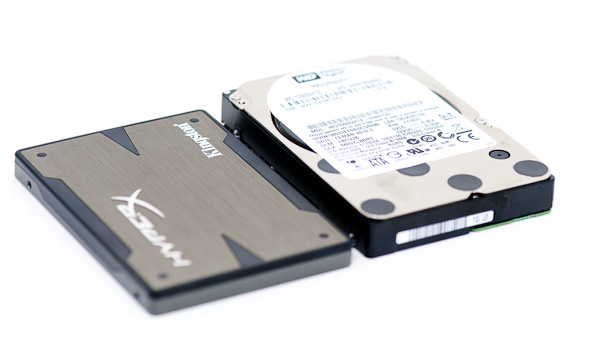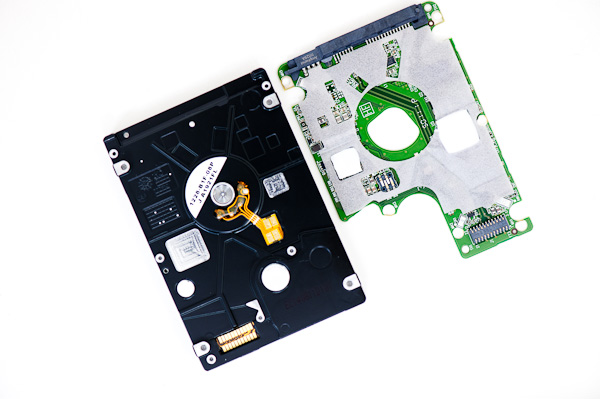Western Digital VelociRaptor 1TB (WD1000DHTZ) Review
by Anand Lal Shimpi on April 16, 2012 8:00 AM EST- Posted in
- Storage
- HDDs
- Western Digital
- VelociRaptor
Final Words
The new VelociRaptor does reclaim its title as world's fastest client hard drive, and I do appreciate the fact that WD hasn't raised prices on the drive in the past two years either. Compared to any 3.5" drive on the market today, the new VR is significantly faster without a doubt. Random IO performance is at least double most 3.5" drives, and sequential performance is almost 50% better than the fastest competitors. Most impressive is the fact that power consumption is actually competitive with modern 3.5" green drives as well, another benefit of the VR's 2.5" package.
The biggest problem for the new VR today is the same issue we had two years ago: SSDs are much faster, and are quickly becoming more affordable. As a primary drive I wouldn't recommend the VelociRaptor simply because you can get a better overall experience with an SSD. We have a number of very reliable, reasonably affordable (128GB), high-performing SSD options to choose from. Intel's lineup, Samsung's SSD 830 and Crucial's m4 all come to mind.
As secondary storage, the new VelociRaptor appeals to those users who need more capacity than an SSD can affordably offer, for active use. Launching applications, games, and working on (not just streaming for playback) large data files are all going to be quicker on the VR than on a standard 3.5" drive. If you're building the ultimate workstation, you could use an SSD + VR for internal storage coupled with some larger, slower drives in RAID as a backup or for your more passive data (movies, music, edited photos). For most users however, I'd honestly recommend an SSD plus a couple of large, 5400/7200RPM drives in RAID-1 for everything you can't store on your SSD. While the Raptor line was quickly embraced by the enthusiast, I believe it has transitioned exclusively to a workstation role.
I have to admit I was disappointed to see that Western Digital went conservative on the new VelociRaptor design and didn't include any on-board NAND to really mix things up. What I was hoping for was a combination of the VelociRaptor and Seagate's Momentus XT. Perhaps that doesn't make sense given the available SSD caching solutions available today, but I don't see the harm in pairing even a small amount of NAND with the drive. I don't see hard drives going away anytime soon, so we might as well try to make accessing them as quick as possible.
Then there's the extreme option. I would love to see a manufacturer treat a hard drive as an SSD with a mechanical counterpart, rather than a hard drive with some NAND on it. I'm curious to see what a VelociRaptor (or any other 2.5" HDD) with 64GB of NAND used as a read/write cache would behave like. If users are able to fit all of their program, apps and data into a 128GB SSD, I have to believe that a well managed cache can deliver compelling performance with half that space.
Unfortunately most hard drive companies seem slow to adopt NAND into their designs, so I suspect much of this will have to be a dream for now. The new VelociRaptor is a great evolution of the design and it's truly a very fast hard drive. Just as before, if I needed to buy a high-performance mechanical hard drive, it's the one I'd pick.












92 Comments
View All Comments
JNo - Monday, April 16, 2012 - link
Meh.This drive line sadly is like a dinosaur in more than just one way...
Honestly not trolling and I still own a 60GB raptor myself but we're in a new era where I find it hard to understand what this brings to the table. I'm not saying *someone* might need it but you'll almost always do better with small SSD + HDD or an SSD acting as cache for a cheap HDD.
Metaluna - Monday, April 16, 2012 - link
I think a lot of OEMs and enterprises shy away from multi-drive setups because of the perception that they are harder to set up and manage than just having everything on one big drive, especially if you are trying to support naive users who tend to splatter files all over the place, particularly for Windows installations.Plus, as far as I know, the only company that supports SSD caching is Intel, so you need their chipsets and their drivers, which only work on Windows.
Then you have laptops, which only have one physical drive bay usually, but this drive won't fit in them anyway so that's a moot point.
gwolfman - Monday, April 16, 2012 - link
@AnandTech:Please short stroke an affordable, yet high performance HDD to a 1TB capacity (e.g., a 3TB HDD short-stroked to 1TB) and compare performance. I'd wager a bit that the short-stroked HDD would perform equal to or better than the new Raptor. ;) Please, pretty please!?!
bollwerk - Monday, April 16, 2012 - link
I don't see why anyone would buy one of these for ~$300, when you can get a 750GB Momentus XT for ~$150.kyuu - Monday, April 16, 2012 - link
Agreed. The Momentus XT outperforms the Velociraptor in the more meaningful benches, can be put into a laptop, runs quieter and cooler (by far), and is half the $/GB. If you need the faster sequential speed, you can RAID0 two Momentus XTs, pay the same price as one of these and get better performance and more capacity.Or, y'know, just get an SSD and pair it with a normal HDD (or pair your SSD with a Momentus XT, like I did).
By not including some form of NAND caching, Western Digital doomed these drives to obsolescence before they were even released.
I'm wondering when Seagate is going to get around to releasing the new Baracudda XT so we'll have a 3.5" HDD with NAND caching for desktops, although even the older 500GB Momentus XT is doing a bang-up job as the companion HDD to my SSD in my desktop rig.
Jeff7181 - Monday, April 16, 2012 - link
This sucks. Should have included at least 20 GB of NAND.
marraco - Monday, April 16, 2012 - link
Anand, please do a roundup of PCI/PCI-e cards with Sata 6gbps expansion. My mother is an x58, and the only fault it haves is lack of SATA III support.Is not worth upgrading the mother, memory and processor just to update SATA, and there is little information on SATA cards.
Nihility - Monday, April 16, 2012 - link
I'm in the same boat.Got 2 SSDs hooked up to SATA 2. It's such a waste :(
LordConrad - Monday, April 16, 2012 - link
Two of these new VelociRaptors in RAID 0 would be awesome for video editing. Great performance without thrashing the life out of an SSD.twotwotwo - Monday, April 16, 2012 - link
The 3.5" form factor is really 101.6mm wide (says Wikipedia) and 2.5 inch drives are 69.85mm wide, leaving 31.75mm of width "free". An mSATA/mini-PCIe SSD is 30mm wide. So, without opening up the HDD black box, there'd be room (just barely) for an mSATA SSD and a splitter/adapter--you'd have to figure out heat dissipation, and it'd present itself to the system as two drives, but a product with a big-enough SSD and a huge HDD in one bay would be kinda interesting.And there're probably very good engineering reasons not to do this, but putting the mSATA SSD in at an angle would make a bit more horizontal room if the HDD needs space for heat dissipation, etc.
(Frankenstein idea #3: stack one of the many existing <7mm-thick 2.5" SSDs (e.g., an Intel one minus the spacer) on top of a a 7mm, 5400-7200rpm laptop hard drive, throw in a SATA splitter, and put it all in a box shaped like a a 3.5" HDD. As you see in reviews here, some existing SSDs are very thin PCBs surrounded by empty space/thermal pads/spacers on top, so the geometry, at least, could work.)